Urban ag delivers $33B in eco services, says Google and NSF
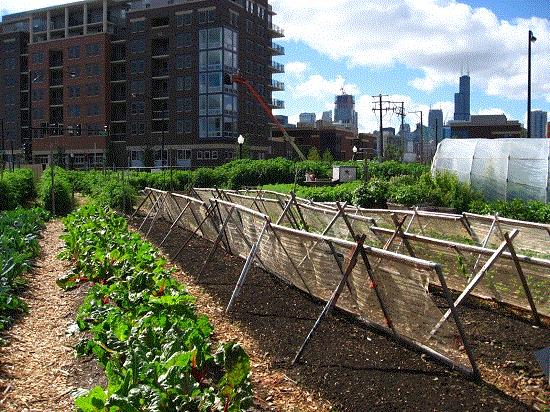
Some Chicago urban farms grow in the shadow of building construction. Credit: Wikimedia Commons
Urban ag matters.
A team funded by the National Science Foundation (NSF) and led by Arizona State University (ASU) and Google researchers has assessed the value of urban agriculture and quantified its global benefits. They report their findings in a paper published this month in the American Geophysical Union journal Earth's Future.
The team estimates that worldwide, when aggregated, urban ag provides about $33 billion in ecosystems services. Further, they estimate that with intense implementation, the overall worth of urban agriculture could be as much as $80 to $160 billion annually worldwide.
When we talk about feeding the world, food production from the small city plots may be hyper-locally impactful, but it’s not enough to feed the populous. However, food production is just one benefit of urban agriculture.
"We've known there are benefits to having these small plots of land in our cities, but we found that the benefits extend well beyond having fresh food in the hands of those who consume it," explained lead author Nicholas Clinton of Google Inc.
The work, the researchers say, provides more than an accounting of urban agriculture in a single scenario. It can be used as a tool for future assessments of the changing urban agriculture landscape to understand trade-offs among urban design strategies.
Hopefully, they’ve developed a tool that can be leveraged by planners in cities like New York where urban ag is thriving.
See: Researchers outline the interconnected benefits of urban agriculture by the National Academies of Science.
A Global Geospatial Ecosystem Services Estimate of Urban Agriculture by Nicholas Clinton, Michelle Stuhlmacher, Albie Miles, Nazli Uludere, Melissa Wagner, Matei Georgescu, Chris Herwig and Peng Gong in Earth’s Future (open access).
___________________________________________________

NYC’s urban ag play: Is a website a big deal? (Opinion)
Recently, the New York City Council unanimously approved Int 1661-2017 sponsored by Councilman Rafael Espinal. The local bill requires the Department of City Planning, Department of Small Business Services, and the Department of Parks and Recreation to develop an urban agriculture website by July 1, 2018. It’s a positive move for sure, but did a website literally require a vote of the City Council? It’s easy for a politician to support “gathering more information,” which is what the website is supposed to do in part.
But the bill that passed was significantly less than the original bill, which would have required the city to write an urban ag plan, clarify the regulatory framework around urban ag and develop policies targeted to easing new urban farmers entry into the market. The urban regulatory framework is a maze, with jurisdictional sandboxes that are often illogical. That’s because politics and history have formed them.
In my day job, I work in public policy in agriculture -- to be specific, specialty crops. Very few, if any, urban-local food operations that I've encountered could stand the financial lens focused by land values in a city like New York. Any number of other uses will deliver greater economic value. But allowing urban agriculture to take root in the interstices has extreme public benefits. The biggest of which is building a sense of community around a living system and connecting people to plants, place and to food. When those people are children, the impact is compounded throughout their entire life.
Formally facilitating urban agriculture is filled with pitfalls for politicians. Just a few of the policy questions that immediately come to mind: How “permanent” will the land use be? What constituents will be against it? Will coalitions develop that form political blocks to other uses of any specific urban ag space? Will there be a future expectation that land used for urban ag receives special tax treatment? Special labor law treatment?
Studying an issue is one way to proverbially kick the can down the road while placating interest groups. New York City’s urban farms will not be dominating the local supermarket supply chain, that’s true. However, they will and they do: Provide healthy outdoor activity to thousands of residents; Provide healthy food; Supply amazing restaurants and farmers markets; Provide a sense of community; Give hope to the underserved; Develop a sense of place; Provide jobs; Spur related entrepreneurial activity; Infiltrate rain water; Harbor pollinators; and much, much more. How the information developed from and on the NYC urban ag website is leveraged in the future is TBD. Will it become a source of data that urban ag proponents translate into greater policy? Or will it be a dead end landing pad?
Based on the dynamic presentations from business, non-profit and institutions in support of the original bill to the New York City Council, I’m betting New York’s dynamic urban ag community is going to prevail—eventually.
But, folks in New York City, do us all a favor: when you guys talk about the need for city support for urban ag, stop comparing yourself to other cities. New York City stands alone in the world. You are an amazing place. You’re leading in urban ag. If Boston or Chicago or Detroit or Los Angeles or even Newark is more supportive of urban ag from a policy perspective, who cares? They're not New York City. Your food scene, your residents, your dynamic arts and business start-up community are second to no one else. Stop comparing yourself and focus on the amazing things you've been able to accomplish even in light of the hurdles. Local food and entrepreneurial farmers are centering topics in politics. Everyone wants them. Help the politicians get on board the successful train you’ve already developed.
See: The Politics of NYC’s Urban Farming: The City Notices Urban Agriculture by Nina Sparling for the Hunter College New York City Food Policy Center blog.
___________________________________________________

Ohio is the latest state to ban invasives
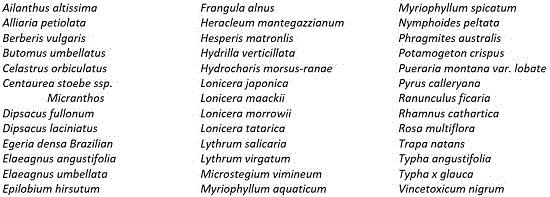
Thirty-eight plants are on the first list of invasives banned for sale or distribution in the state of Ohio created by the Ohio Department of Agriculture.
The law (codified at 901:5-30-01 Invasive Plant Species) creating the invasives list provides for the opportunity to allow for cultivars of plants that are demonstrated not to be invasive. Prohibition on the sale/distribution for two plants on the list that are currently in trade will be phased in: Lythrum virgatum will be prohibited in one year and Pyrus calleryana in five years.
The new regulations will be enforced by the Department of Agriculture’s Plant Health Division that houses their Nursery and Dealer Inspection and Certification Program. Illegal invasive plants may be seized and destroyed.
The Department of Agriculture is also assembling a five-person invasive plant advisory committee to oversee the list.
__________________________________________________
San Diego’s natives mainly pollinated by non-native honey bees
In San Diego, where honey bees aren't native, they're responsible for 75% of pollinator visits to native plants, the highest honey bee dominance in the set of networks examined for any continental site in the introduced range of the honey bee. This is despite the fact that there are more than 650 species of native bees in San Diego County, as well as many other native pollinating insects.
An unprecedented study integrating data from around the globe has shown that honey bees are the world's most important single species of pollinator in natural ecosystems and a key contributor to natural ecosystem functions.
The report recently published in Proceedings of the Royal Society B weaves together information from 80 plant-pollinator interaction networks. The results identify the honey bee (Apis mellifera) as the single most frequent visitor to flowers of naturally occurring (non-crop) plants worldwide. Honey bees were recorded in 89% of the pollination networks in the honey bee's native range and 61% in regions where honey bees have been introduced by humans.
One out of eight interactions between a non-agricultural plant and a pollinator is carried out by the honey bee, the study revealed. The honey bee's global importance is further underscored when considering that it's but one of tens of thousands of pollinating species in the world, including wasps, flies, beetles, butterflies, moths and other bee species.
Honey bees “are currently the most successful pollinators in the world," said Keng-Lou James Hung, who led the study as a graduate student in UC-San Diego's Division of Biological Sciences. He's now a post-doc at the Ohio State University.
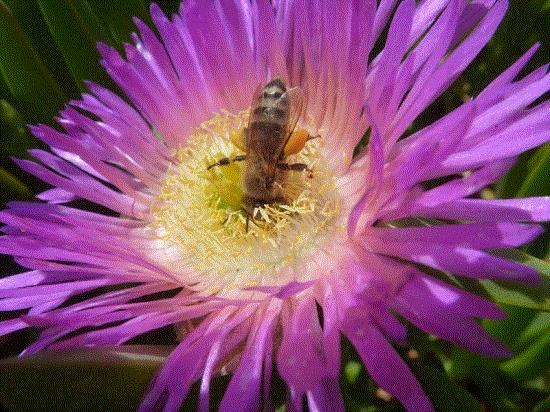
A honey bee visits Carpobrotus (a native to Australia that’s planted on many highways in San Diego County). Photo: Keng-Lou James Hung, University of California San Diego
Honey bees are native to Africa, the Middle East and Southern Europe and have become naturalized in ecosystems around the world. While feral honey bee populations may be healthy in many parts of the world, the health of managed honey bee colonies is threatened by a host of factors.
The study also confirms what pollination biologists have known for a long time: “Even in the presence of a highly abundant species that pollinates many plant species, we still need healthy populations of other pollinators for entire plant communities to receive adequate pollination services," James said.
The reason for this, he explains, is that in habitats where honey bees are present, they fail to visit nearly half of all animal-pollinated plant species, on average.
The worldwide importance of honey bees as pollinators in natural habitats by Keng-Lou James Hung, Jennifer M. Kingston, Matthias Albrecht, David A. Holway and Joshua R. Kohn in Proceedings of the Royal Society Biological Sciences (open access).
___________________________________________________

Celastrus scandens (native) or C. orbiculatus? Mislabeled at retail
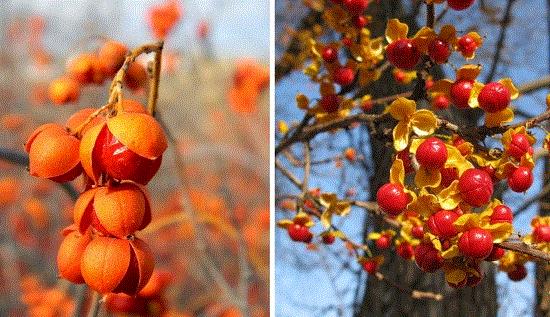
American bittersweet, left, has red berries encased in orange capsules, while Oriental bittersweet, right, has red berries encased in bright yellow capsules. (Photos: Bonnie K. Qwert)
Gardeners hoping to celebrate the beauty of American bittersweet, Celastrus scandens, may be buying invasive bittersweet instead. That's because many Midwestern retailers are selling Oriental bittersweet with labels misidentifying it as the native plant, researchers report. These sales are occurring in stores and online.
Unlike American bittersweet (Celastrus scandens), Oriental bittersweet (Celastrus orbiculatus) grows aggressively, girdles saplings and smothers even mature trees, said Illinois Natural History Survey plant ecologist David Zaya.
"Oriental bittersweet changes ecosystems, it changes forests," he said. "The vines can live for decades and its seeds are spread by birds."
The vines also outcompete American bittersweet by pollinating female flowers on the native plants, he said. Almost all the hybrids are sterile, leading to a reproductive dead-end for the native plants.
"Meanwhile, oriental bittersweet almost never has hybrid seeds," he said.
David published findings in Invasive Plant Science and Management, a result of an investigation begun after he heard reports of native bittersweet plants behaving strangely.
He bought 34 plants labeled "American bittersweet" from 11 vendors based in Indiana, Illinois, Missouri and Nebraska and compared them with wild, correctly identified bittersweet plants. He purchased the plants in stores and online.
He found that 54% of the purchased plants labeled "American bittersweet" and/or "Celastrus scandens" were in fact Oriental bittersweet. Seven of the 11 vendors tested were selling mislabeled plants. Four of these were located in Illinois, where it's illegal to sell oriental bittersweet.
Some of the mislabeled plants had photographs of oriental bittersweet on their labels. Both species produce red berries, but oriental bittersweet berries have a bright yellow outer capsule, which is easily distinguishable from the orange capsule of American bittersweet berries.
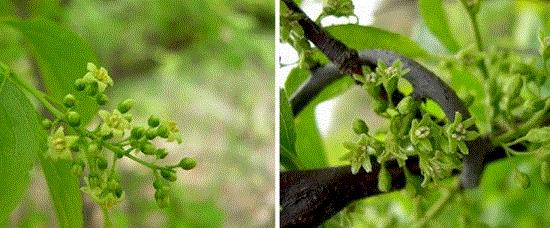
Male flowers of American bittersweet have yellow pollen and occur in bunches at the end of a stem (left). Male flowers of Oriental bittersweet have white pollen and occur in groups along the whole stem (right). (Photos: Stacey Leicht-Young)))
Some garden centers selling small plants are very plausibly making an honest mistake. But at some point along the supply chain, "someone is being irresponsible or dishonest," he said.
Nearly all of the bittersweet plants he bought online were invasives mislabeled as natives. He urges people to question retail managers about their suppliers and stock, to find out what steps they're taking to ensure they're selling the right plants.
"And if it has a picture with yellow berries, don't buy it - and please bring it to my attention so I can contact that seller."
Mislabeling of an Invasive Vine (Celastrus orbiculatus) as a Native Congener (C. scandens) by David N. Zaya, Stacey A. Leicht-Young, Noel B. Pavlovic and Christopher S. Hetrea in Invasive Plant Science and Management.
___________________________________________________

Vegetated rain gardens handled 90% of rain events
More than half of all stormwater-- and 90% of the rain events--over a four-year period were handled in vegetated rain gardens that were monitored in Cincinnati, Ohio.
The study of one single two-tiered rain garden located at an apartment complex in Cincinnati was to gain an understanding of how well the plant and soil components function in reducing stormwater volumes for the city’s CSO. The structures were constructed in the fall of 2010 to handle drainage from about 2.2 acres of roads, parking lot, turf and woods.
The rain garden featured 2 to 4 in. of hardwood chip mulch on top of 18 to 24 in. of engineered soils. Underneath is a 14-in. drainage layer (#57 gravel aggregate wrapped in geotextile fabric). This all sits on top of silty clay subsoil made from shale parent material with limestone fragments. There are PVC pipe underdrains in the gravel layer. Plants included both native and introduced generalist species.
The garden was monitored from April 2012 through October 2015. To gain an understanding of function when the rain garden facilities are most needed to reduce CSOs, the team looked at 233 (April–October) storm events to study effectiveness. What they found was that the rain garden helped to buffer more than 50% of the stormwater volume from the CSO.
Once plants became established, they proved to be instrumental in helping to move water out of the system through evapotranspiration. By 2016, vegetation canopy coverage was estimated at 97%.
“Although the thick surface mulch layer likely restricted evaporative loss, the amount of transpiration may have increased due to increased vegetative cover and presumably increased removal of soil moisture through likewise expanded root systems. Our analysis suggests that total event rainfall depth (an input) and evapotranspiration (a loss) are primary factors regulating flows through the rain garden network,” the authors wrote.
They also found that longer rain events delivered more stormwater through the rain garden. Storm intensity was less important, leading to speculation that rainfall totals were more important than the rate at which the rain fell.
The rain gardens “achieved more than 50% overall volume retention capacity and 90% of all rainfall events were fully detained in the gardens. For a storm event that drove the rain gardens to release flow to the CSS (10% of all events), we found that the flows into the local combined sewer system were delayed off-peak for an average of 5.5 hours.”
In other words, here’s more evidence that vegetated rain gardens work!
Factors Contributing to the Hydrologic Effectiveness of a Rain Garden Network (Cincinnati OH USA) by William D. Shuster, Robert A. Darner, Laura A. Schifman and Dustin L. Herrmann in Infrastructures.
_______________________________________________________________
Feeling like you may be losing it? Get nature. There’s an app.
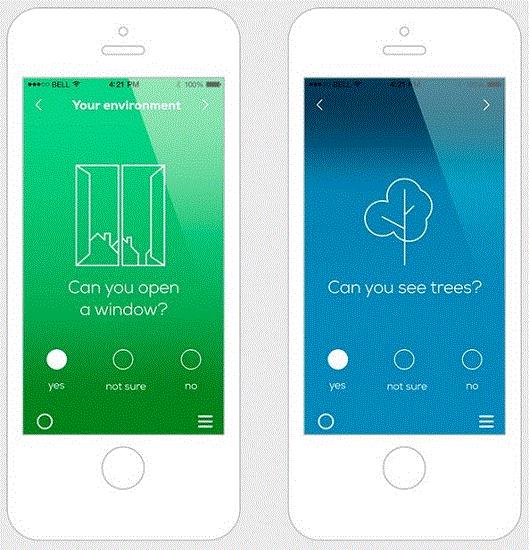
Urban Mind screen shots. Urban Mind is an app that measures your experience of city living in the moment. By collecting real-time data, the researchers are able to understand how different aspects of the urban environment affect mental wellbeing.
(twitter.com/Urban_Mind_Proj facebook.com/UrbanMindProject/ instagram.com/urban_mind_project/)
Researchers at King's College London, landscape architects J & L Gibbons and art foundation Nomad Projects have used smartphone-based technology to assess the relationship between nature in cities and momentary mental well-being in real time.
They found that: 1) being outdoors, seeing trees, hearing birds sing, seeing the sky and feeling in contact with nature were associated with higher levels of mental well-being; and 2) that the beneficial effects of nature were especially evident in those individuals with greater levels of impulsivity who are at greater risk of mental health issues. The researchers developed a smartphone-based app, Urban Mind, to examine how exposure to natural features in cities affects a person's mental well-being.
The Urban Mind app monitored 108 individuals who collectively completed 3,013 assessments over a one-week period.
The results showed significant immediate and time-lagged associations with mental well-being for several natural features: trees, the sky and birds singing. These associations were still evident several hours after exposure, indicating time-lasting benefits.
Johanna Gibbons and Neil Davidson, J & L Gibbons, said, "Right now decisions on urban planning and design aimed at improving mental health tend to be based on ‘conventional wisdom,’ due to the lack of robust scientific data. Our findings provide a much-needed evidence base for the benefits of nature within urban centers. From the perspective of urban planning and design, we hope the results will inform future investments and policies, helping build heathier cities."
—from Study suggests exposure to trees, the sky and birdsong in cities beneficial for mental wellbeing by King’s College London.
Urban Mind: Using Smartphone Technologies to Investigate the Impact of Nature on Mental Well-Being in Real Time by Ioannis Bakolis, Ryan Hammoud, Michael Smythe, Johanna Gibbons, Neil Davidson, Stefania Tognin and Andrea Mechelli in BioScience.
____________________________________________________________
Events
January 17-19: Western Nursery & Landscape Association (MO)
A number of sessions on the Western Nursery & Landscape Association program will feature plant functionality under the banner Plants with Purpose that will highlight the economic, environmental and quality-of-life benefits of plants.
The event will kick-off on Wednesday evening at Boulevard Brewing Company and celebrate the many purposes of plants with a video introduction by Dr. Charlie Hall and a series of fast-paced presentations on the benefits of plants. Other sessions include: Rick Darke presenting “The Essential Layers of Living Landscapes” and a “Dynamic, Conservation-based Landscape Design Workshop;” Rebecca Lindenmeyr on “Nature Integration – The Future of Design;” Dr. Robert Lyons on “The Color of the Native Plant Palette: Herbaceous Considerations and Other Related Thoughts.” Roundtable discussions will include: “Promoting Plants & Their Purposes at the Nebraska Statewide Arboretum;” “Designing with Native Plants in Residential Landscapes;” “Native Plant Stewardship Training;” and a discussion led by Dr. Jennifer Reithel of the Rocky Mountain Biological Laboratory. Grow Native! Will present an entire track of education.
February 2018: Organic Land Care Certificate (NJ)
Introduction to Organic Land Care-Certificate Course is a four-day training offered by Rutgers Cooperative Extension of Monmouth County. Dates are February 5, 6, 12 and 13. More than 20 university and industry experts teach the course and share their experience of how to successfully transition a landscape to organic management and add organic services to a business. The course focuses on organic practices for promoting healthy soil, enhancing biodiversity and reducing polluted runoff from managed landscapes. The course is designed for professional landscapers, property managers, public works employees, groundskeepers, landscape architects and Rutgers Master Gardeners.
February 6-9: NOFA Organic Land Care (CT)
The NOFA Organic Land Care curriculum is based on NOFA’s Standards for Land Care: Practices for Design and Maintenance of Ecological Landscapes and includes 30 hours of instruction over four days. The course has been designed for professionals with five years of experience. At the end of the program, students may take an exam to become an Accredited Organic Land Care Professional. Questions? Call (203) 308-2584 or email jeremy@ctnofa.org.
February 22-23: 2018 Land & Water Summit (NM)
The Ripple Effect: Stormwater & Tree Canopy is the theme for the 2018 Land & Water Summit sponsored by the Xeriscape Council of New Mexico to be held in Albuquerque, New Mexico, at the Albuquerque Airport Sheraton. The opening Keynote, “Climate Resilience: A new paradigm of change” will be delivered by Mike McMahon, HDR Engineering.
February 23 Green Matters: Restoring Urban Landscapes (MD)
How can we design our landscapes in ways that prevent harm to existing ecosystems and regenerate the environment? Join Green Matters, an annual symposium sponsored by Brookside Gardens that concentrates attention on the intersection of horticulture and environmental issues. This year’s event, Restoring Our Urban Landscapes, will be held at the Silver Spring Civic Building in Silver Spring. Talks are to include: "Biophillic Urbanism: A New Approach for Creating Sustainable Environments" by Dr. Timothy Beatley and Teresa Heinz, University of Virginia; "Creating Healthy Soils Through Regenerative Gardening Practices" by Jeff Lowenfels, author and columnist; "Habitat Matters: Restoring Ecosystem Functionality & Biodiversity" by Heather Holm, horticulturist, biologist, writer and landscape designer; and "Lessons In Landscape Design: Integrating Natural Systems into the Built Environment" by Kate Hayes, Associate, SCAPE Landscape Architecture DPC.
March 7-8: 24th Annual ELA Conference & Eco-Marketplace (MA)
This year’s Ecological Landscape Alliance annual meeting is under the working title “Maximizing Landscape Potential.” Two workshops will be held on Day 1: Carbon Sequestration and Productive Landscape Case Studies followed by the keynote, landscape architect Darrel Morrison, on “How Ecology Can Inform Landscape Design.” Concurrent sessions will feature sessions on Landscape Design Focus, Ecological Practice and Idea Exchange Panels and Demonstration.
February 10/June 14: River-Friendly Green Gardener (CA)
The half-day course Integrated Pest Management II: An Advanced Perspective is back by popular demand. The program will be offered twice at different times and days -- February 10 at the La Sierra Community Center in Carmichael and June 14 at the Folsom Community Center in Folsom. Instructor Steve Zien will go beyond the basics to discuss landscape pest identification (including new species) key strategies to prevent pests and management options from cultural controls to pesticides.
The seminar will focus on Holistic Pest Management, which acknowledges that plants and their pests function in a shared ecological system. You'll learn how to keep this system in balance and discourage pests before they get out of hand.
___________________________________________________
Worth reading
Best,

Debbie Hamrick
NewTerrain
This email was received by 18,424 readers.
If you're interested in advertising in NewTerrain, contact Kim Brown.